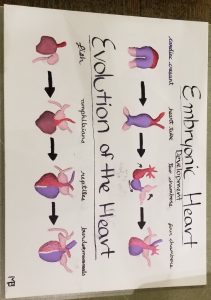
My project depicts an embryonic heart in comparison with the evolution of a heart in mammals. Both start with a modified tube heart, and progress into a four chambered heart. Reptiles and a fetus, both of which evolve and develop further, have incomplete septums shown in white. Generalized regions of the heart are color coordinated to show origin.

For Megan Booysen’s STEAM project she decided to go with cardiovascular system; specifically the evolution of the heart and the embryonic development of the heart. She decided to cover three objectives concerning the cardiovascular system; 1) describe the major steps of fetal development, 2) analyze the evolutionary history of the heart, and 3) explain the structure and function of the heart. For the medium and materials, she decided to use a poster board and painted the diagrams of the heart. The poster board looks neat and professional; the heart diagrams are perfectly painted—way better than I could ever dream of doing.
So the main concept of this project is that the embryonic heart development over gestation (first 50 days) goes through very similar stages that the heart went through over thousands of years during evolution. This is really fascinating that the embryonic heart development basically mimics evolution in a condensed version (matter of months) when the heart is developing. This project is very informative in describing in detail how the heart develops. Basically, during development and similar in evolution (as shown in the diagrams), they both develop into a heart tube that’s bulbous and linear. Next, they both begin to develop a primitive type chamber (sometimes 2 chambers). These chambers continue to develop and eventually the heart develops into four chambers; a right and left ventricle, and a right and left atrium.
This evolutionary development of four chambers was essential to mammals, especially to humans who are endothermic animals. Evolution solved the problem of only having one heart that was trying to pump oxygenated blood throughout the entire body and then somehow pump carbon dioxide back for gas exchange to occur at the lungs. This problem was solved with the four-chambered heart that separates the pulmonary circuit and the systemic circuit. This project does a good job at showing how, in only 50 days (during gestation), embryonic development mimics the evolution of the heart; each stage is visually expressed through painted diagrams.